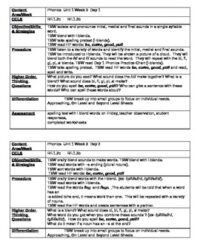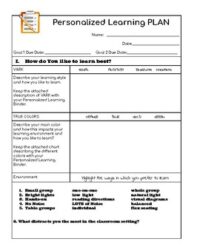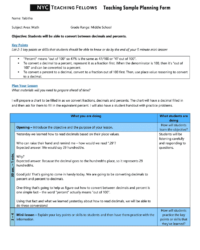Imagine a classroom where every student feels truly seen, where their unique strengths are nurtured, and their individual challenges are met with tailored support. It sounds like a dream, right? But with the right tools, like an individual student lesson plan template, this personalized learning environment is not just a fantasy; it’s an achievable reality. In today’s diverse educational landscape, moving beyond a one-size-fits-all approach is becoming increasingly vital for student success and engagement.
Traditional lesson planning, while effective for group instruction, often leaves gaps for students who learn differently, require extra attention, or are ready to accelerate. This is where the power of individualized planning truly shines. By focusing on a single student’s needs, educators can create a learning journey that is precisely calibrated to foster their growth, build confidence, and maximize their potential. It’s about empowering students to take ownership of their education, and empowering educators to make a profound, targeted impact.
The Transformative Impact of Personalized Education
In an era where educational needs are more varied than ever, understanding and responding to individual learning styles, paces, and interests is paramount. Personalized education isn’t just a buzzword; it’s a pedagogical approach that recognizes the inherent uniqueness of each learner. When a lesson plan is crafted specifically for one student, it moves beyond general objectives and delves into concrete, measurable goals that are relevant to that student’s current abilities and future aspirations. This approach significantly boosts student motivation because they can clearly see how the learning directly applies to them.
Consider a student who struggles with reading comprehension but excels in hands-on activities. A generic lesson might assign more reading, potentially increasing frustration. However, an individualized plan could incorporate tactile learning tools, visual aids, or even role-playing to improve comprehension in a way that resonates with their strengths. Similarly, a gifted student might become disengaged if the pace of group instruction is too slow. An individual plan can provide accelerated content, independent research projects, or opportunities for peer tutoring, keeping them challenged and stimulated.
Identifying Key Student Needs
Before you even begin filling out an individual student lesson plan template, the most crucial step is a thorough assessment of the student. This isn’t just about academic levels; it’s about understanding their interests, learning preferences, emotional state, and any potential barriers to learning. Observing them in different settings, communicating with parents or guardians, and engaging in open conversations with the student themselves can provide invaluable insights. Are they visual learners, auditory, kinesthetic? Do they thrive with structure or prefer more autonomy? What motivates them?
Setting SMART Goals for Individual Growth
Once you have a clear picture, the next step is to set Specific, Measurable, Achievable, Relevant, and Time-bound (SMART) goals. These goals should be co-created with the student whenever possible, fostering a sense of ownership and responsibility. For example, instead of “improve math skills,” a SMART goal might be “By the end of the next three weeks, [Student Name] will accurately solve 4 out of 5 two-digit multiplication problems using the lattice method during independent practice sessions.” This clarity provides a roadmap for both the student and the educator.
The beauty of this focused approach is its adaptability. An individual student lesson plan template allows for continuous adjustment based on real-time progress and emerging needs. It’s a dynamic document, not a static one. As the student masters one skill, the plan can evolve to tackle the next challenge, ensuring a consistent and personalized learning trajectory that truly maximizes their potential.
Structuring Your Effective Individual Student Lesson Plan Template
While the specific format of an individual student lesson plan template might vary, certain core components are essential for creating a comprehensive and actionable document. Think of it as a personalized blueprint for success, guiding both your instruction and the student’s learning journey. A well-designed template ensures that all critical aspects of a student’s educational needs are addressed systematically, leaving no stone unturned in their pursuit of knowledge and skill development.
Building out this template effectively means thinking through each phase of the learning process for that specific student. It’s not about rigid adherence to a form, but using it as a flexible framework to capture crucial details. This systematic approach ensures consistency, allows for tracking progress, and facilitates clear communication among all stakeholders involved in the student’s education, including parents, support staff, and the student themselves. It turns vague intentions into concrete actions.
Here are some key elements you’ll typically find or want to include in a robust individual student lesson plan template:
- Student Information and Background: Include the student’s name, grade level, and a brief summary of their learning profile, including strengths, challenges, and any relevant accommodations or modifications required.
- Learning Goals and Objectives: Clearly state the specific, measurable goals for the lesson or unit, tied directly to the student’s identified needs.
- Materials and Resources: List all necessary textbooks, worksheets, online tools, manipulatives, or other resources needed for the lesson.
- Instructional Strategies: Detail the specific teaching methods you will employ, tailored to the student’s learning style (e.g., direct instruction, guided practice, collaborative learning, hands-on activities).
- Differentiation and Accommodations: Outline any specific adjustments made to content, process, product, or learning environment to meet the student’s unique needs.
- Assessment and Progress Monitoring: Describe how you will assess the student’s understanding and progress, including formative and summative assessments, and how you will track their growth over time.
- Reflection and Next Steps: A section for notes on what worked well, what challenges arose, and what adjustments need to be made for future lessons to ensure continuous improvement.
Embracing the concept of an individualized student learning path is more than just good teaching practice; it’s a commitment to equity and excellence in education. By taking the time to understand and cater to each student’s unique journey, educators can unlock potential that might otherwise remain dormant within a more generalized learning environment. This thoughtful approach cultivates not only academic success but also fosters a love for learning, resilience, and self-advocacy in students.
Ultimately, investing in personalized planning empowers students to thrive, building a strong foundation for their future academic and life successes. It transforms the learning experience from a passive reception of information into an active, engaging, and deeply personal adventure. The rewards are immeasurable, for both the student discovering their capabilities and the educator witnessing such profound individual growth.


